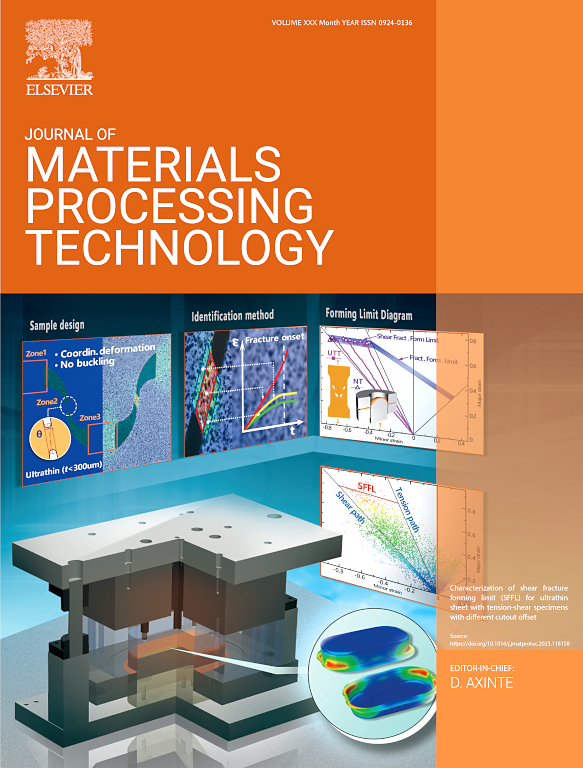增材制造Inconel 718合金的化学辅助磁流变整理
IF 6.7
2区 材料科学
Q1 ENGINEERING, INDUSTRIAL
Journal of Materials Processing Technology
Pub Date : 2025-05-22
DOI:10.1016/j.jmatprotec.2025.118910
引用次数: 0
摘要
增材制造的Inconel 718由于其良好的机械和摩擦学性能,广泛用于各种高温部件的开发。在大多数情况下,需要精确的表面处理,以提高这些部件的功能性能。在本研究中,采用一种包括标准磁流变精加工(MRF)和化学辅助磁流变精加工(CAMRF)工艺的多步骤精加工策略,实现了激光直接能量沉积(led)技术制备的Inconel 718涂层的纳米级表面精加工。首先,对地面进行标准磁磁共振成像,获得210 nm的表面粗糙度(Sa)。由于Inconel 718的硬度较高,MRF工艺的有效性有限,限制了标准MRF工艺的性能,最终导致涂层抛光不均匀。为了进一步提高涂层表面的表面光洁度,引入了CAMRF,采用了两种不同的IN 718化学腐蚀剂,即腐蚀剂1(即糖基试剂)和腐蚀剂2(即氢氟酸(HF)基)。两种化学腐蚀剂在MR流体中的最佳体积%为8 %。在CAMR过程中,由于化学腐蚀剂的氧化性,CAMR流体带中的腐蚀剂与表面峰相互作用,表面被氧化。因此,Inconel 718主要成分的氧化物(即NiO, Cr2O3等)形成(即钝化膜)。x射线光电子能谱(XPS)分析证实了氧化物形成的假设。这种钝化膜使表面凸起/峰变弱,不易去除。因此,那些钝化的弱颗粒很容易被CAMRF工具中磨料颗粒的磨损作用剪切掉。由于化学腐蚀和机械磨损的综合作用,CAMRF工艺的有效性高于标准MRF工艺。CAMRF与蚀刻剂1和蚀刻剂2的表面粗糙度Sa分别为145 nm和100 nm。在CAMRF中使用蚀刻剂2,由于HF的高反应活性,形成了稳定的氧化膜,从而改善了表面光滑度。与地面涂层相比,涂层的摩擦系数和比磨损率分别降低了44% %和49% %,这表明涂层的摩擦学性能得到了显著改善。本文章由计算机程序翻译,如有差异,请以英文原文为准。
Chemical-assisted magnetorheological finishing of additively manufactured Inconel 718 alloy
Additively manufactured Inconel 718 is extensively engaged for the developments of various high temperature components owing to its favourable mechanical and tribological properties. In most of the cases, precision surface finishing is required for better functional performance of those components. In the present study, a multi-step finishing strategy is employed that comprises standard magnetorheological finishing (MRF) and chemical-assisted magnetorheological finishing (CAMRF) processes to achieve nano-scale surface finish of Inconel 718 coating fabricated via laser direct energy deposition (LDED) technique. At first, standard MRF is conducted over the ground surface and a surface roughness (Sa) of 210 nm is achieved. The performance of standard MRF process is restricted owing to the considerably higher hardness of Inconel 718 and limited effectiveness of MRF process and that finally leads to the non-uniform polishing of coating. To further improve the surface finish of coated surface, CAMRF is introduced with the employment of two distinct chemical etchants of IN 718, i.e., etchant 1 (i.e., glyceregia reagent) and etchant 2 (i.e., hydrofluoric acid (HF) based). The optimized vol% of both chemical etchants in MR fluids is found to be 8 %. During CAMRF process, the etchant present in CAMR fluid ribbon interacts with the surface peaks and the surface gets oxidized owing to the oxidizing nature of the chemical etchant. As a consequence, the oxides of major constituents of Inconel 718 (i.e., NiO, Cr2O3, etc.) are formed (i.e., passivation film). This hypothesis of oxide formation is confirmed by X-ray photoelectron spectroscopy (XPS) analysis. This passivation film makes the surface asperities/peaks weak and less resistant to removal. As a results, those passivated and weak asperities get sheared off easily by the abrasion action of the abrasive particles present in the CAMRF tool. Due to these integrated effects of chemical etching and mechanical abrasion, the effectiveness of CAMRF process is higher than the standard MRF process. The surface roughness (Sa) associated with CAMRF with etchant 1 and etchant 2 is found to be 145 nm and 100 nm, respectively. The improved surface finish in CAMRF with etchant 2 is attributed to the formation stable oxide film owing to the high reactivity of HF. The friction coefficient and specific wear rate of finished coating are reduced by almost 44 % and 49 % than the ground coating, respectively and this indicates a significant improvement in tribological performance of the finished coating.
求助全文
通过发布文献求助,成功后即可免费获取论文全文。
去求助
来源期刊

Journal of Materials Processing Technology
工程技术-材料科学:综合
CiteScore
12.60
自引率
4.80%
发文量
403
审稿时长
29 days
期刊介绍:
The Journal of Materials Processing Technology covers the processing techniques used in manufacturing components from metals and other materials. The journal aims to publish full research papers of original, significant and rigorous work and so to contribute to increased production efficiency and improved component performance.
Areas of interest to the journal include:
• Casting, forming and machining
• Additive processing and joining technologies
• The evolution of material properties under the specific conditions met in manufacturing processes
• Surface engineering when it relates specifically to a manufacturing process
• Design and behavior of equipment and tools.
 求助内容:
求助内容: 应助结果提醒方式:
应助结果提醒方式:


